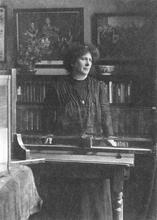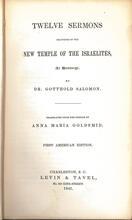Marion Hartog
Born in England, Marion Hartog and her sister Celia Moss wrote and published their first book of poems, Early Efforts, in 1839, before publishing a collection of historical romances entitled The Romance of Jewish History. This book and its sequel, Tales of Jewish History, are among the first works of fiction ever published by Jewish women anywhere in the world; they promoted reform of English Jews’ gender and religious practices and an early version of political Zionism. In 1855, Hartog published the first issue of The Jewish Sabbath Journal, the first Jewish women’s periodical in history. Here she published stories about women who become successful independent artists, sermons, and meditations on mother/child and mother/daughter relationships. Despite its initial success, other Jewish publications refused to support her periodical, and she was forced to close it five months later.
Early Life and Writing Career
Marion Hartog, editor of the first Jewish women’s periodical in history, was born in Portsmouth, England, the fourth of twelve children of Joseph Moss (c.1780–c.1840), profession unknown, and Amelia (c.1780–c.1850). Amelia Moss was the granddaughter of the founder of Portsmouth Jewish Congregation and the daughter of Sarah Davids, the first Jewish child born in Portsmouth.
Joseph Moss read widely to his children—Lord Byron, Walter Scott, and Charlotte Brontë, among others—and as children Marion and her older sister Celia (1819–1873) entertained the family with their own fairy tales. However, when their father discovered his daughters committing their tales to writing, he decided that literary endeavor was unseemly for girls and threatened to burn their books. Nonetheless, after an extended illness prevented him from supporting the family, Marion and Celia Moss wrote and secretly published their first book of poems, Early Efforts (1839). They dedicated the volume to Sir George Staunton, M.P. (1781–1859), and got up a subscription consisting of most of the prominent Jewish families in London.
The following year, encouraged by the success of Early Efforts, the Mosses published a collection of historical romances titled The Romance of Jewish History (1840, 2nd ed. 1843). Dedicated by permission to Edward Bulwer Lytton (1803–1873), this book and its sequel, Tales of Jewish History (1843), adapted the Jewish romance genre—first established by Walter Scott in Ivanhoe—to Anglo-Jewish needs. To the prominent Jews who sponsored them, these tales were entry-tickets to social and political toleration among English Christians. Among the first fictions ever published by Jewish women anywhere in the world, the tales promoted reform of English Jews’ gender and religious practices as well as an early version of political Zionism.
In the early 1840s, Marion and Celia Moss moved to London. In 1845, Marion married her French teacher, Alphonse Hartog, and the new couple, together with Celia, opened a boarding school for girls at the home they shared at 68 Mansell Street, Goodman’s Fields. While teaching, the sisters continued writing poetry and tales for the Jewish Chronicle and the American Jewish periodical The Occident.
The Jewish Sabbath Journal and Later Life
In July 1854, Marion Hartog brought out a prospectus for a new periodical, The Jewish Sabbath Journal: A Penny and Moral Magazine for the Young, which Hartog described as “the dream of more than half my life.” Victorian Jewish women were expected to oversee the religious and moral education of their children, yet many of them lacked any formal religious training. The Jewish Sabbath Journal sought to alleviate the situation in which (as Hartog put it in her prospectus) most Jewish children “receive their education at Christian public schools, or from private Christian teachers.”
Endorsed by no less of an Anglo-Jewish eminence than Abraham Benisch (1814–1878), the editor of the community newspaper, The Jewish Chronicle, the journal was published by subscription, the first number appearing on February 22, 1855. It quickly became popular among Jewish women readers and attracted new female writers in the community. Hartog published stories about women who become successful independent artists. She published sermons—among English Jews at the time an exclusively male genre. She published meditations on mother/child and mother/daughter relationships, and satires on the efforts of conversionists to ensnare Jewish girls.
At first, the journal’s reception seemed positive. The Chief Rabbi of the British Empire Nathan Marcus Adler (1803–1890) approved the project. Hartog’s hopes began to wane, however, as weeks passed with no notice from The Jewish Chronicle. Hartog complained of the silence in an editorial in the Jewish Sabbath Journal. On March 23, 1855, Benisch responded by publishing a review of the Journal in which he accused Hartog of promoting “superstition” and laying down “doctrines which we consider un-Jewish.” As a result, Hartog’s subscriptions fell off and she closed the journal some five months after its inauguration with a poem “On the Death of My Beloved Child.”
In the fifty years that followed, Hartog published only sporadically, instead dedicating herself to running various schools. After 1857, when Celia Moss married a local shohet, Edward Levetus, and moved to Birmingham, Hartog ran the schools herself. Several of Hartog’s children, who included Numa (1846–1869), Marcus, Helena, Cecile and Philip (1864–1947), became well known as scientists and artists. Numa became the first Jewish Senior Wrangler at Trinity College, Cambridge in 1869. His success prompted passage of the University Tests Act and his death at the age of twenty-three was seen as a community tragedy.
Marion Hartog died at her home at 22 Brondesbury Villas, Kilburn, on October 29, 1907 at the age of eighty-six.
Advertisement. Jewish Chronicle, 12 December 1845.
Cheyette, Bryan, ed. The Oxford History of the Novel in English, vol. 7: British and Irish Fiction Since 1940. Oxford: Oxford University Press, 2016.
Galchinsky, Michael. The Origin of the Modern Jewish Woman Writer: Romance
and Reform in Victorian England. Detroit: 1996.
Hartog, Mabel. Philip Hartog: A Memoir. London: 1949.
Hartog, Marion, ed. The Jewish Sabbath Journal. No. 1–11. February–June, 1855.
Manuscript Library, University College London.
“Jewish Women’s Work in Philanthropy and Education.” Jewish Chronicle (June
13, 1902); “Marion Hartog: From a Correspondent.” Jewish Chronicle (August 23, 1895).
Moss, Celia and Marion. Early Efforts. A Volume of Poems by the Misses Moss, of
the Hebrew Nation. Aged 18 and 16. London: 1839.
Moss, Celia and Marion. The Romance of Jewish History. 3 vols. 2nd ed. London:
1843.
Moss, Celia and Marion. Tales of Jewish History. 3 vols. London: 1843.
Obituary, “Madame Alphonse Hartog,” Jewish Chronicle (November 1, 1907).
“Romance of Jewish History” MS 160, AJ 167/1–2, Hartley Library Special
Collections, University of Southampton.





